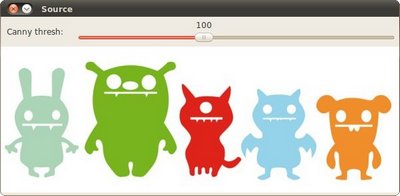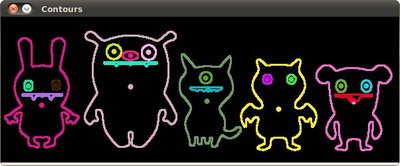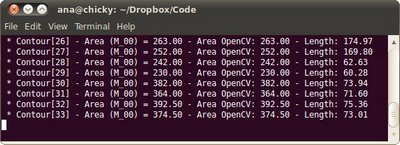Image Moments
Table of Contents
Prev Tutorial: Creating Bounding rotated boxes and ellipses for contours
Next Tutorial: Point Polygon Test
| Original author | Ana Huamán |
| Compatibility | OpenCV >= 3.0 |
Goal
In this tutorial you will learn how to:
- Use the OpenCV function cv::moments
- Use the OpenCV function cv::contourArea
- Use the OpenCV function cv::arcLength
Theory
Code
C++
This tutorial code's is shown lines below. You can also download it from here
#include "opencv2/imgcodecs.hpp"
#include "opencv2/highgui.hpp"
#include "opencv2/imgproc.hpp"
#include <iostream>
#include <iomanip>
using namespace cv;
using namespace std;
Mat src_gray;
int thresh = 100;
RNG rng(12345);
void thresh_callback(int, void* );
int main( int argc, char** argv )
{
CommandLineParser parser( argc, argv, "{@input | stuff.jpg | input image}" );
if( src.empty() )
{
cout << "Could not open or find the image!\n" << endl;
cout << "usage: " << argv[0] << " <Input image>" << endl;
return -1;
}
cvtColor( src, src_gray, COLOR_BGR2GRAY );
blur( src_gray, src_gray, Size(3,3) );
const char* source_window = "Source";
namedWindow( source_window );
imshow( source_window, src );
const int max_thresh = 255;
createTrackbar( "Canny thresh:", source_window, &thresh, max_thresh, thresh_callback );
thresh_callback( 0, 0 );
waitKey();
return 0;
}
void thresh_callback(int, void* )
{
Mat canny_output;
Canny( src_gray, canny_output, thresh, thresh*2, 3 );
vector<vector<Point> > contours;
findContours( canny_output, contours, RETR_TREE, CHAIN_APPROX_SIMPLE );
vector<Moments> mu(contours.size() );
for( size_t i = 0; i < contours.size(); i++ )
{
mu[i] = moments( contours[i] );
}
vector<Point2f> mc( contours.size() );
for( size_t i = 0; i < contours.size(); i++ )
{
//add 1e-5 to avoid division by zero
static_cast<float>(mu[i].m01 / (mu[i].m00 + 1e-5)) );
cout << "mc[" << i << "]=" << mc[i] << endl;
}
for( size_t i = 0; i< contours.size(); i++ )
{
drawContours( drawing, contours, (int)i, color, 2 );
circle( drawing, mc[i], 4, color, -1 );
}
imshow( "Contours", drawing );
cout << "\t Info: Area and Contour Length \n";
for( size_t i = 0; i < contours.size(); i++ )
{
cout << " * Contour[" << i << "] - Area (M_00) = " << std::fixed << std::setprecision(2) << mu[i].m00
<< " - Area OpenCV: " << contourArea(contours[i]) << " - Length: " << arcLength( contours[i], true ) << endl;
}
}
void imshow(const String &winname, InputArray mat)
Displays an image in the specified window.
void drawContours(InputOutputArray image, InputArrayOfArrays contours, int contourIdx, const Scalar &color, int thickness=1, int lineType=LINE_8, InputArray hierarchy=noArray(), int maxLevel=INT_MAX, Point offset=Point())
Draws contours outlines or filled contours.
double contourArea(InputArray contour, bool oriented=false)
Calculates a contour area.
double arcLength(InputArray curve, bool closed)
Calculates a contour perimeter or a curve length.
"black box" representation of the file storage associated with a file on disk.
Definition: core.hpp:106
STL namespace.
Java
This tutorial code's is shown lines below. You can also download it from here
import java.awt.BorderLayout;
import java.awt.Container;
import java.awt.Image;
import java.util.ArrayList;
import java.util.List;
import java.util.Random;
import javax.swing.BoxLayout;
import javax.swing.ImageIcon;
import javax.swing.JFrame;
import javax.swing.JLabel;
import javax.swing.JPanel;
import javax.swing.JSlider;
import javax.swing.event.ChangeEvent;
import javax.swing.event.ChangeListener;
import org.opencv.core.Core;
import org.opencv.core.CvType;
import org.opencv.core.Mat;
import org.opencv.core.MatOfPoint;
import org.opencv.core.MatOfPoint2f;
import org.opencv.core.Point;
import org.opencv.core.Scalar;
import org.opencv.core.Size;
import org.opencv.highgui.HighGui;
import org.opencv.imgcodecs.Imgcodecs;
import org.opencv.imgproc.Imgproc;
import org.opencv.imgproc.Moments;
class MomentsClass {
private Mat srcGray = new Mat();
private JFrame frame;
private JLabel imgSrcLabel;
private JLabel imgContoursLabel;
private static final int MAX_THRESHOLD = 255;
private int threshold = 100;
private Random rng = new Random(12345);
public MomentsClass(String[] args) {
String filename = args.length > 0 ? args[0] : "../data/stuff.jpg";
Mat src = Imgcodecs.imread(filename);
if (src.empty()) {
System.err.println("Cannot read image: " + filename);
System.exit(0);
}
Imgproc.cvtColor(src, srcGray, Imgproc.COLOR_BGR2GRAY);
Imgproc.blur(srcGray, srcGray, new Size(3, 3));
// Create and set up the window.
frame = new JFrame("Image Moments demo");
frame.setDefaultCloseOperation(JFrame.EXIT_ON_CLOSE);
// Set up the content pane.
Image img = HighGui.toBufferedImage(src);
addComponentsToPane(frame.getContentPane(), img);
// Use the content pane's default BorderLayout. No need for
// setLayout(new BorderLayout());
// Display the window.
frame.pack();
frame.setVisible(true);
update();
}
private void addComponentsToPane(Container pane, Image img) {
if (!(pane.getLayout() instanceof BorderLayout)) {
pane.add(new JLabel("Container doesn't use BorderLayout!"));
return;
}
JPanel sliderPanel = new JPanel();
sliderPanel.setLayout(new BoxLayout(sliderPanel, BoxLayout.PAGE_AXIS));
sliderPanel.add(new JLabel("Canny threshold: "));
JSlider slider = new JSlider(0, MAX_THRESHOLD, threshold);
slider.setMajorTickSpacing(20);
slider.setMinorTickSpacing(10);
slider.setPaintTicks(true);
slider.setPaintLabels(true);
slider.addChangeListener(new ChangeListener() {
@Override
public void stateChanged(ChangeEvent e) {
JSlider source = (JSlider) e.getSource();
threshold = source.getValue();
update();
}
});
sliderPanel.add(slider);
pane.add(sliderPanel, BorderLayout.PAGE_START);
JPanel imgPanel = new JPanel();
imgSrcLabel = new JLabel(new ImageIcon(img));
imgPanel.add(imgSrcLabel);
Mat blackImg = Mat.zeros(srcGray.size(), CvType.CV_8U);
imgContoursLabel = new JLabel(new ImageIcon(HighGui.toBufferedImage(blackImg)));
imgPanel.add(imgContoursLabel);
pane.add(imgPanel, BorderLayout.CENTER);
}
private void update() {
Mat cannyOutput = new Mat();
Imgproc.Canny(srcGray, cannyOutput, threshold, threshold * 2);
List<MatOfPoint> contours = new ArrayList<>();
Mat hierarchy = new Mat();
Imgproc.findContours(cannyOutput, contours, hierarchy, Imgproc.RETR_TREE, Imgproc.CHAIN_APPROX_SIMPLE);
List<Moments> mu = new ArrayList<>(contours.size());
for (int i = 0; i < contours.size(); i++) {
mu.add(Imgproc.moments(contours.get(i)));
}
List<Point> mc = new ArrayList<>(contours.size());
for (int i = 0; i < contours.size(); i++) {
//add 1e-5 to avoid division by zero
mc.add(new Point(mu.get(i).m10 / (mu.get(i).m00 + 1e-5), mu.get(i).m01 / (mu.get(i).m00 + 1e-5)));
}
Mat drawing = Mat.zeros(cannyOutput.size(), CvType.CV_8UC3);
for (int i = 0; i < contours.size(); i++) {
Imgproc.drawContours(drawing, contours, i, color, 2);
Imgproc.circle(drawing, mc.get(i), 4, color, -1);
}
imgContoursLabel.setIcon(new ImageIcon(HighGui.toBufferedImage(drawing)));
frame.repaint();
System.out.println("\t Info: Area and Contour Length \n");
for (int i = 0; i < contours.size(); i++) {
System.out.format(" * Contour[%d] - Area (M_00) = %.2f - Area OpenCV: %.2f - Length: %.2f\n", i,
mu.get(i).m00, Imgproc.contourArea(contours.get(i)),
Imgproc.arcLength(new MatOfPoint2f(contours.get(i).toArray()), true));
}
}
}
public class MomentsDemo {
public static void main(String[] args) {
// Load the native OpenCV library
System.loadLibrary(Core.NATIVE_LIBRARY_NAME);
// Schedule a job for the event dispatch thread:
// creating and showing this application's GUI.
javax.swing.SwingUtilities.invokeLater(new Runnable() {
@Override
public void run() {
new MomentsClass(args);
}
});
}
}
Python
This tutorial code's is shown lines below. You can also download it from here
from __future__ import print_function
from __future__ import division
import cv2 as cv
import numpy as np
import argparse
import random as rng
rng.seed(12345)
def thresh_callback(val):
threshold = val
canny_output = cv.Canny(src_gray, threshold, threshold * 2)
contours, _ = cv.findContours(canny_output, cv.RETR_TREE, cv.CHAIN_APPROX_SIMPLE)
# Get the moments
mu = [None]*len(contours)
for i in range(len(contours)):
mu[i] = cv.moments(contours[i])
# Get the mass centers
mc = [None]*len(contours)
for i in range(len(contours)):
# add 1e-5 to avoid division by zero
mc[i] = (mu[i]['m10'] / (mu[i]['m00'] + 1e-5), mu[i]['m01'] / (mu[i]['m00'] + 1e-5))
# Draw contours
drawing = np.zeros((canny_output.shape[0], canny_output.shape[1], 3), dtype=np.uint8)
for i in range(len(contours)):
color = (rng.randint(0,256), rng.randint(0,256), rng.randint(0,256))
cv.drawContours(drawing, contours, i, color, 2)
cv.circle(drawing, (int(mc[i][0]), int(mc[i][1])), 4, color, -1)
cv.imshow('Contours', drawing)
# Calculate the area with the moments 00 and compare with the result of the OpenCV function
for i in range(len(contours)):
print(' * Contour[%d] - Area (M_00) = %.2f - Area OpenCV: %.2f - Length: %.2f' % (i, mu[i]['m00'], cv.contourArea(contours[i]), cv.arcLength(contours[i], True)))
parser = argparse.ArgumentParser(description='Code for Image Moments tutorial.')
parser.add_argument('--input', help='Path to input image.', default='stuff.jpg')
args = parser.parse_args()
src = cv.imread(cv.samples.findFile(args.input))
if src is None:
print('Could not open or find the image:', args.input)
exit(0)
# Convert image to gray and blur it
src_gray = cv.cvtColor(src, cv.COLOR_BGR2GRAY)
src_gray = cv.blur(src_gray, (3,3))
source_window = 'Source'
cv.namedWindow(source_window)
cv.imshow(source_window, src)
max_thresh = 255
thresh = 100 # initial threshold
cv.createTrackbar('Canny Thresh:', source_window, thresh, max_thresh, thresh_callback)
thresh_callback(thresh)
cv::String findFile(const cv::String &relative_path, bool required=true, bool silentMode=false)
Try to find requested data file.
int createTrackbar(const String &trackbarname, const String &winname, int *value, int count, TrackbarCallback onChange=0, void *userdata=0)
Creates a trackbar and attaches it to the specified window.
CV_EXPORTS_W Mat imread(const String &filename, int flags=IMREAD_COLOR)
Loads an image from a file.
void cvtColor(InputArray src, OutputArray dst, int code, int dstCn=0)
Converts an image from one color space to another.
void circle(InputOutputArray img, Point center, int radius, const Scalar &color, int thickness=1, int lineType=LINE_8, int shift=0)
Draws a circle.
void Canny(InputArray image, OutputArray edges, double threshold1, double threshold2, int apertureSize=3, bool L2gradient=false)
Finds edges in an image using the Canny algorithm .
void blur(InputArray src, OutputArray dst, Size ksize, Point anchor=Point(-1,-1), int borderType=BORDER_DEFAULT)
Blurs an image using the normalized box filter.
Moments moments(InputArray array, bool binaryImage=false)
Calculates all of the moments up to the third order of a polygon or rasterized shape.
void findContours(InputArray image, OutputArrayOfArrays contours, OutputArray hierarchy, int mode, int method, Point offset=Point())
Finds contours in a binary image.
Explanation
Result
Here it is: 


 1.9.6
1.9.6